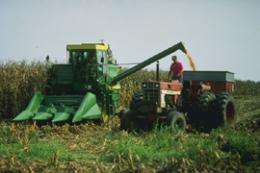Studying Fertilizers to Cut Greenhouse Gases

(PhysOrg.com) -- Agricultural Research Service (ARS) scientists have found that using alternative types of fertilizers can cut back on greenhouse gas emissions, at least in one part of the country. They are currently examining whether the alternatives offer similar benefits nationwide.
Nitrogen fertilizers are often a necessity for ensuring sufficient crop yields, but their use leads to release of nitrous oxide, a major greenhouse gas, into the atmosphere. Fertilizer use is one reason an estimated 78 percent of the nation's nitrous oxide emissions come from agriculture, according to Ardell Halvorson, a soil scientist at the ARS Soil Plant Nutrient Research Laboratory in Fort Collins, Colo.
Halvorson compared nitrous oxide emissions from corn fields treated with either a conventional nitrogen fertilizer (urea) or either of two specially formulated urea fertilizers—one with "controlled release" polymer-coated pellets, and the other with inhibitors added to "stabilize" the urea to keep more of it in the soil as ammonium for a longer period.
In a two-year experiment at Fort Collins, he collected the emissions using static vented chambers, similar to small "pillbox" structures placed over the soil. He chose a no-till cropping system because it's known to reduce carbon dioxide emissions. He found that the controlled-release fertilizer cut nitrous oxide emissions by a third, and that the stabilized fertilizer cut them almost in half.
Halvorson's results are so far limited to the irrigated fields and cool, semi-arid conditions in and around Fort Collins. But nitrous oxide releases are the result of a complex interplay of conditions that vary from one area to the next, such as soil water content, soil temperatures, soil types, microbial activity, climactic conditions and rainfall patterns. So Halvorson is expanding the study, with support from the fertilizer industry and cooperation of other ARS locations, to see how the fertilizers respond at seven sites around the United States.
Read more about ARS climate change research in the November/December 2009 issue of Agricultural Research magazine.
Provided by USDA Agricultural Research Service















